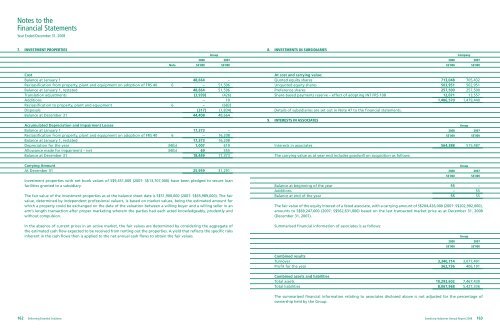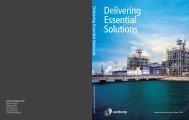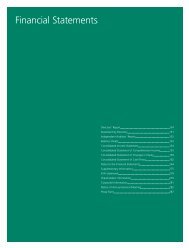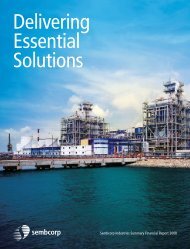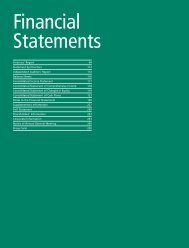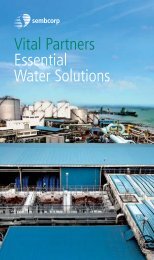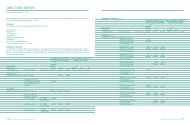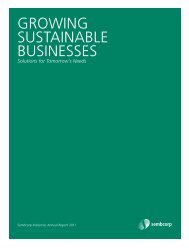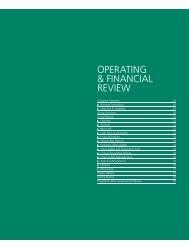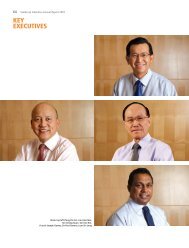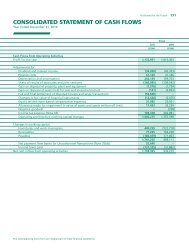Statutory Reports - Sembcorp
Statutory Reports - Sembcorp
Statutory Reports - Sembcorp
Create successful ePaper yourself
Turn your PDF publications into a flip-book with our unique Google optimized e-Paper software.
Notes to theFinancial StatementsYear Ended December 31, 20082. SUMMARY OF SIGNIFICANT ACCOUNTING POLICIES (cont’d)d. Property, Plant and Equipment (cont’d)iv. DisposalsGains or losses arising from the retirement or disposal of property, plant and equipment are determined asthe difference between the estimated net disposal proceeds and the carrying amount of the asset and arerecognised in the income statement on the date of retirement or disposal.For property, plant and equipment carried at revalued amounts, any related revaluation surplus is transferredfrom the revaluation reserve to accumulated profits and is not taken into account in arriving at the gain orloss on disposal.v. Finance Lease AssetsFinance leases are those leasing agreements that give rights approximating to ownership. Property, plant andequipment acquired by way of such leases is capitalised at the lower of its fair value and the present valueof the minimum lease payments at the inception of the lease, less accumulated depreciation and impairmentlosses.Lease payments are apportioned between the finance charges and reduction of the lease liability so as toachieve a constant rate of interest on the remaining balance of the liability.Finance charges are charged directly to the income statement.Capitalised leased assets are depreciated over the shorter of the economic useful life of the asset and the leaseterm.vi. Provision for Restoration CostsA provision is recognised for the costs expected to be incurred to dismantle, remove and restore the asset uponexpiry of the lease agreement. The estimated costs form part of the cost of the property, plant and equipmentand are depreciated over the useful life of the asset.vii. DepreciationDepreciation is calculated using the straight-line method to allocate the cost less its residual value so as to writeoff items of property, plant and equipment over their estimated useful lives. Each part of an item of property,plant and equipment with a cost that is significant in relation to the total cost of an item is depreciatedseparately. The estimated useful lives are as follows:2. SUMMARY OF SIGNIFICANT ACCOUNTING POLICIES (cont’d)e. Investment PropertiesInvestment properties comprise significant portions of office buildings and freehold land that are held for longtermrental yields or for capital appreciation, or both.Investment properties are initially recognised at cost and subsequently carried at cost less accumulated depreciationand accumulated impairment losses. Depreciation is recognised in the income statement on a straight-line basisover the estimated useful lives ranging from 20 to 50 years. The assets’ depreciation methods, useful lives andresidual values are reviewed, if not insignificant, annually, and adjusted if appropriate. No depreciation is providedon the freehold land.Investment properties are subject to renovations or improvements at regular intervals. The cost of majorrenovations and improvements is capitalised as additions and the carrying amounts of the replaced componentsare written off to the income statement. The cost of maintenance, repairs and minor improvements is charged tothe income statement when incurred.On disposal of an investment property, the difference between the estimated net disposal proceeds and thecarrying amount of the asset is recognised in the income statement.f. Intangible Assetsi. GoodwillGoodwill represents the excess of the cost of acquisition over the fair value of the Group’s share of theidentifiable net assets. Goodwill is stated at cost less accumulated impairment losses. Goodwill on acquisitionof subsidiaries is included in intangible assets. Goodwill on acquisition of associates and joint ventures isincluded in investments in associates and joint ventures.ii.Goodwill arising from the acquisition of a minority interest in a subsidiary represents the excess of the cost ofthe additional investment over the carrying amount of the net assets acquired at the date of exchange.Goodwill is tested for impairment on an annual basis in accordance with Note 2(n).Goodwill / Negative Goodwill Previously Written Off Against ReservesGoodwill that has previously been taken to reserves is not taken to the income statement when (i) the businessis disposed of or discontinued or (ii) the goodwill is impaired. Similarly, negative goodwill that has previouslybeen taken to reserves is not taken to the income statement when the business is disposed of or discontinued.Leasehold land and wet berthageLand improvementsBuildingsImprovements to premisesQuays and dry docksFloating docksPlant and machineryMarine vesselsFurniture, fittings and office equipmentTools and workshop equipmentMotor vehiclesLease period ranging from 20 to 60 yearsLease period ranging from 20 to 60 years50 years or lease period ranging from 10 to 50 years, if lower1 to 10 years15 to 60 years20 years3 to 40 years3 to 25 years1 to 10 years3 to 10 years2 to 10 yearsiii. Research and DevelopmentExpenditure on research activities, undertaken with the prospect of gaining new scientific or technicalknowledge and understanding, is recognised in the income statement as an expense as incurred.Expenditure on development activities, whereby research findings are applied to a plan or design for theproduction of new or substantially improved products and processes, is capitalised if the product or processis technically and commercially feasible and the Group has sufficient resources to complete development.The expenditure capitalised includes the cost of materials, direct labour and an appropriate proportion ofoverheads. Other development expenditure is recognised in the income statement as an expense as incurred.Capitalised development expenditure is stated at cost less accumulated amortisation and impairment losses.The assets’ useful lives and residual values are reviewed, if not insignificant, annually, and adjusted if appropriate.No depreciation is provided on freehold land and capital work-in-progress.Amortisation is charged to the income statement on a straight-line basis over the estimated useful life of 10 years.Fully depreciated assets are retained in the financial statements until they are no longer in use.124 Delivering Essential Solutions <strong>Sembcorp</strong> Industries Annual Report 2008 125


